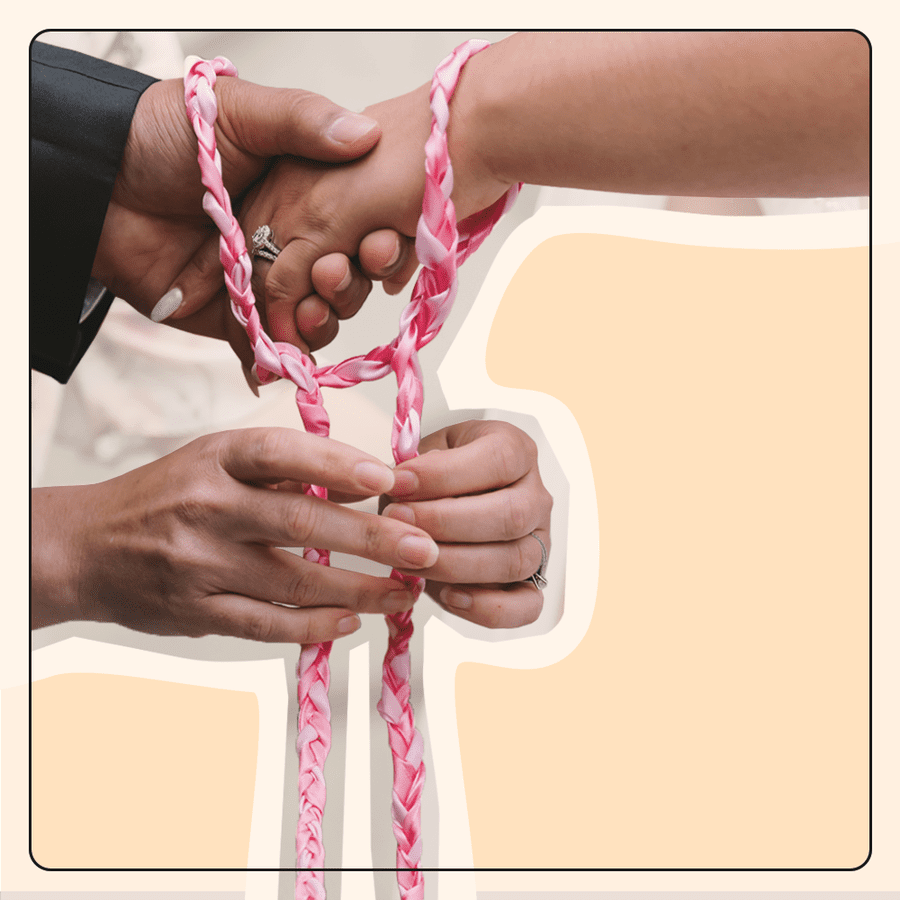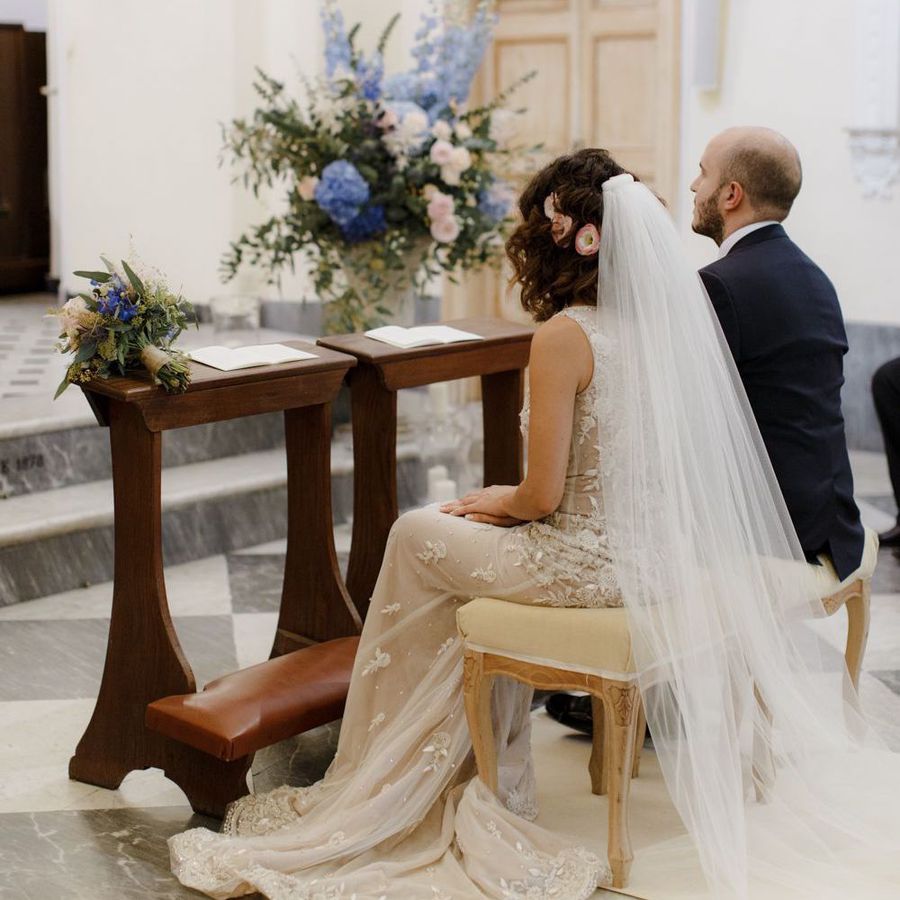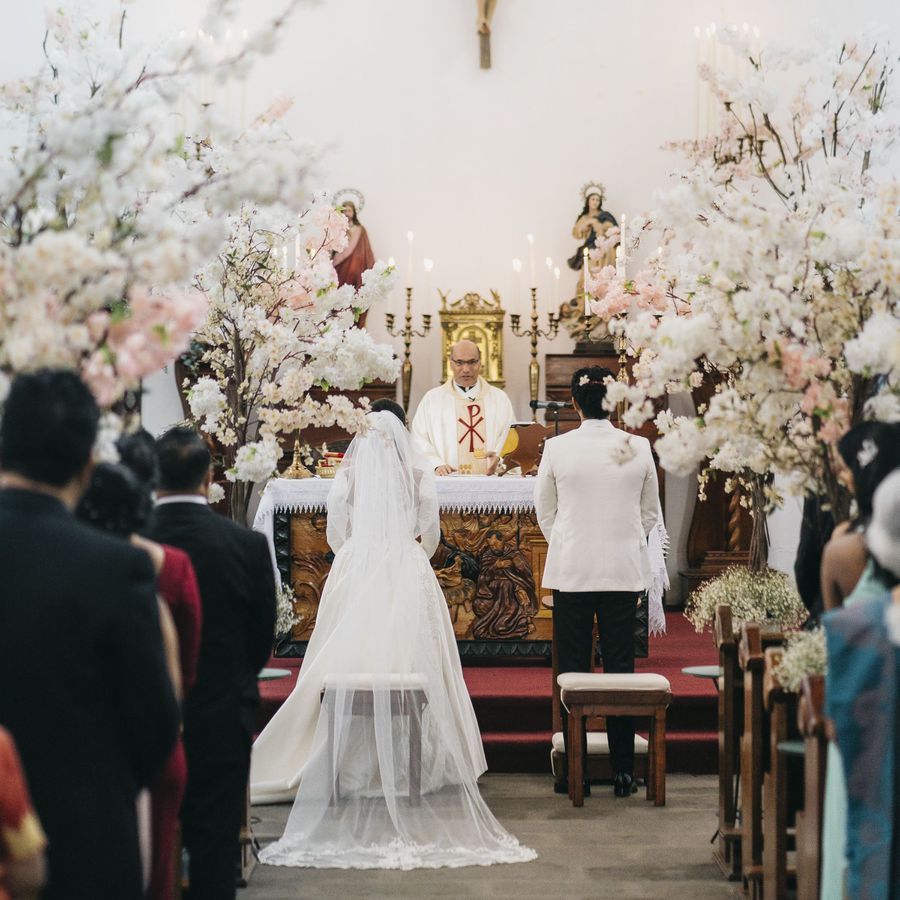:max_bytes(150000):strip_icc()/sq-6547a9fa02cb4ac8b6c058a80ab84fcd.jpg)
Photo by 4EVENTS
When a couple gets engaged they are signifying their intentions to get married. For those who follow the Catholic faith, a betrothal ceremony may take place. A betrothal ceremony or rite of betrothal is a ceremony in the Catholic religion in which a couple pledges to marry one another on a specified date. The agreement is morally binding under canon law.
Although today a betrothal ceremony is no longer required to get married in the Catholic Church, couples choose the tradition because it adds spirituality and gravitas to an often hectic engagement and wedding planning period. It can also be seen as a deeper intent than a simple proposal, where one person asks the other to marry them, as the ceremony is a declaration of both parties to wed.
The History and Meaning of the Betrothal Ceremony
“Betrothal ceremonies originated in the early Church and were more rooted in the social and economic commitments of marriage between families,” explains expert Stephanie Calis. They were a contract, a way for families to enter into an agreement or union with one another before God that could not be broken. They were so important in ancient times that Catholic priests wouldn’t even consider a couple to be engaged until they underwent a betrothal ceremony.
Meet the Expert
Stephanie Calis is the Co-Founder and Editor-in-Chief of Spoken Bride, a lifestyle blog for Catholic couples who are engaged or newlyweds.
Now, betrothal ceremonies are no longer required by the Catholic Church—it’s acceptable for one partner to get down on one knee and pop the question. But couples are still choosing to do them for spiritual reasons. The proceedings help them bring meaning and religion into their wedding planning process. As they are choosing dresses and venues and bands, it reminds them of the seriousness of marriage and refocuses their commitment to one another.
“The ceremony is a great fit for couples who desire this sense of intention and reverence during their time of engagement, and who want to celebrate their upcoming union in a spiritual and community-oriented way,” said Calis. “The ceremony in itself is rich with meaning and can be a source of strength and grace for the couple as they prepare for marriage.”
Betrothal Ceremony FAQs
If you are thinking of having a betrothal ceremony, there are a few things to keep in mind, but most important is the understanding that the rite is not a replacement or legally binding contract for vows of marriage. Here's what you should know:
Is a betrothal ceremony required?
“The Rite of Betrothal is an optional tradition in the Catholic faith,” said Calis. “An engaged couple freely comes forward to verbally commit to their future marriage, stating before witnesses that they pledge to marry one another on a designated date.”
Is a betrothal ceremony binding?
Unlike an engagement, which sets an intention to marry, a betrothal ceremony requires the couple to commit to marry. During the ceremony, a man and a woman pledge themselves to a future union. Although it is not legally binding by secular law, it is under canon law. The church still regards the betrothal as a contract, an agreement spelled out and mutually agreed on by both parties.
Can a betrothal ceremony replace a wedding ceremony?
No, it cannot. The betrothal is different from a marriage contract because it promises future marriage. It does not declare the couple married, only that they vow to make that plan happen.
What happens during a betrothal ceremony?
“During the ceremony, a priest begins the Rite with a prescribed prayer and invites the couple to join hands. The man and woman, in turn, repeat after the priest the words of their pledge to marry. After each has pledged their commitment, the priest blesses the couple with holy water, saying, ‘I declare thee betrothed,’ and blesses the bride-to-be’s engagement ring,” said Calis. “The Rite concludes with Scripture readings or prayer.”
When does a betrothal ceremony take place?
It takes place any time after a couple sets their wedding date and before the wedding (In the ceremony the couple vows to marry one another on a particular date, so that is why the date must be set). Ceremonies are traditionally held after a Mass and are usually short in duration.
Who conducts a betrothal ceremony?
“Typically a couple plans the ceremony with a priest, usually their wedding celebrant,” said Calis. “To plan their ceremony, couples should speak with their celebrant about holding the ceremony and work with him to plan the date, time, and location.”
When should you plan a betrothal ceremony?
Couples should start planning their betrothal ceremony as soon as they have their wedding date, so they can make sure to book the priest and get the date, time, and location they want.
Where does a betrothal ceremony take place?
Most couples opt to have their betrothal ceremony in a church, after mass.
Who is invited to a betrothal ceremony?
Couples can invite anyone they want to attend their betrothal ceremony. Some include extended family and numerous friends, while others stick to the wedding party or immediate families. Many couples choose to have a brunch, dinner, or engagement party after their betrothal ceremony to further celebrate the moment with their friends and family.
What do you wear to a betrothal ceremony?
“Many couples find that dressing up for the ceremony, with women choosing to wear white, lace, or other bridal-type attire, can bring an added significance,” said Calis. “What we wear can reflect the internal state of our hearts, emotions, and intentions.” Guests should also dress up for the ceremony, especially if it’s in a church. Remember, this is a religious ceremony so air on the conservative side!
Can you personalize a betrothal ceremony?
Calis has seen couples create a short program or handout for guests to follow along. Many also personalize the ceremony by having a meal or reception afterward. A newer trend is for the betrothal ceremony to take place before a secular engagement party.
How does a betrothal ceremony differ from Pre-Cana?
A betrothal ceremony is a morally binding intent to wed, whereas Pre-Cana is a consultation course that discusses expectations of marriage (family origin, financial planning, future family planning, etc.), that couples must complete before marriage in the Catholic faith. Both take place before vows, however, Pre-Cana is mandated by the Catholic Church.





